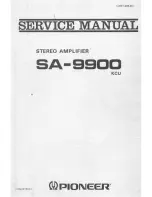
TPD
Jul 2016
10
Amate Audio
After powering up the unit, all LEDs will be lit for about six seconds, while the
following message is displayed on the LCD:
After that, the DSP unit displays its main screen:
Now the unit
is ready to operate. The screen shows the name of the unit (above line)
and the program name currently active (below line). The program assigned is always
the last program the user recalled or stored before powering down the unit. The first
user program is number 31 and programs 1-30 are the factory presets (see
¡Error!
No se encuentra el origen de la referencia.
).
An admiration mark (!) beside the program name means that the program has been
modified but not stored. Read-only presets (1-30) can be only saved as new presets
in the free user slots (31-100).
WARNING:
when no signal is present at the input, the amplifier will
power up in eco mode (Led Eco on). After signal is applied, the normal
operation will start. See section 5.4 for more details.
5.2 DSP Preset selection
In order to properly distribute the frequencies to the different channels, the DSP must
be configured first. To ease this process the
TPD
has built-in presets for the most
common applications, using Amate Audio loudspeakers or generic loudspeakers.
Preset 1 to 10: Generic presets (read-only).
Provide a template for the most common applications using generic
loudspeakers (i.e Xo100+SW4Ohms). The subwoofer channel is configured
with a Low Pass filter of 80, 90, 100, 110 or 120 Hz, and a clip limiter
depending if the load is 4 Ohms or 8 Ohms. The L/R channel is configured
with a HPF also in the range of 80, 90, 100, 110 or 120 Hz. The limiters are
set to the maximum power that can be delivered by the amplifier.
The user can modify the inputs and the outputs, but they cannot be
overwritten.
Preset 11 to 30: Amate Audio presets (read-only).
Initialising...
Amate Audio TPD
! My_Preset
Amate Audio TPD
1 Xo100+SW4Ohms
Summary of Contents for TPD
Page 58: ......











































